31 Water Quality Spotlight: Iowa Great Lakes
As part of an internship, one of our group members performed water quality sampling for a summer around the Iowa Great Lakes. Emalyn (Environmental Science, 2025) worked with the Iowa State Hygienic Laboratory and a team of environmental interns at Iowa Lakeside Laboratory to collect samples from 20 different sites weekly. These sites were selected because they are all major tributaries that feed into the Iowa Great Lakes (West Okoboji, Big Spirit Lake, East Okoboji, Center Lake, Upper and Lower Gar Lake, Minnewashta Lake). A variety of different metrics were collected including dissolved oxygen, pH, water temperature, stream flow, water depth, conductance, turbidity, total dissolved solids (TDS), nitrate level, and any significant landform changes. (EF)
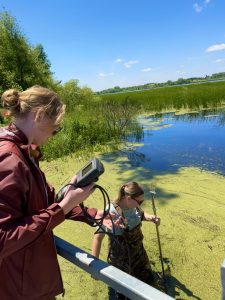
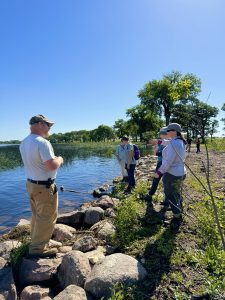
These metrics are crucial for monitoring the health of aquatic ecosystems. Dissolved oxygen, for example, is essential for the survival of fish and other aquatic organisms. Low levels of oxygen can indicate pollution or excessive nutrient loading, which can lead to hypoxia or “dead zones.” pH is a key indicator of water quality because it can affect the solubility and toxicity of chemicals, as well as the biological processes of organisms in the water. Extreme pH levels—either too acidic or too alkaline—can stress aquatic life and disrupt ecosystems. (EF)
Water temperature is another important parameter because it influences the metabolism and reproduction of aquatic organisms. Elevated temperatures, often associated with climate change or thermal pollution from industrial discharge, can lead to lower oxygen levels and alter species distributions. Conductance is a measure of the water’s ability to conduct electricity, which correlates with the concentration of dissolved salts and minerals in the water. High conductance levels can indicate high levels of pollution, particularly from agricultural runoff. (EF)
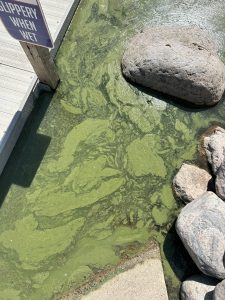 Algae blooms are another major public health concern that is closely linked to water quality. Algal blooms, particularly those caused by cyanobacteria (blue-green algae), can produce harmful toxins that are dangerous for both wildlife and humans. These toxins, such as microcystins, can contaminate drinking water sources, make recreational areas unsafe, and cause severe health problems for humans, including liver damage, respiratory issues, and gastrointestinal illness. Algal blooms are often promoted by high nutrient levels, particularly nitrogen and phosphorus, which can come from agricultural runoff or wastewater discharges. The nitrate levels measured in the water samples can indicate the presence of excess nutrients that may contribute to these blooms. Regular monitoring for both algal blooms and their associated toxins is essential for protecting the health of those who use the lakes for recreation and as a drinking water source. (EF)
Algae blooms are another major public health concern that is closely linked to water quality. Algal blooms, particularly those caused by cyanobacteria (blue-green algae), can produce harmful toxins that are dangerous for both wildlife and humans. These toxins, such as microcystins, can contaminate drinking water sources, make recreational areas unsafe, and cause severe health problems for humans, including liver damage, respiratory issues, and gastrointestinal illness. Algal blooms are often promoted by high nutrient levels, particularly nitrogen and phosphorus, which can come from agricultural runoff or wastewater discharges. The nitrate levels measured in the water samples can indicate the presence of excess nutrients that may contribute to these blooms. Regular monitoring for both algal blooms and their associated toxins is essential for protecting the health of those who use the lakes for recreation and as a drinking water source. (EF)
Digital YSI pH meters were used to collect conductance data, pH levels, and dissolved oxygen content. These instruments were calibrated in the lab before each sampling session, and they had to be properly handled in order to function efficiently. The sensors were rinsed after each use to ensure the results were not skewed or contaminated with other samples. This careful handling is essential to ensure data accuracy and consistency, which are vital for assessing the health of the lakes and their surrounding environments. (EF)
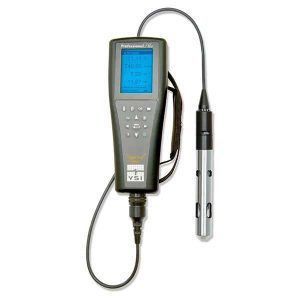
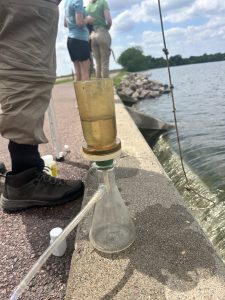
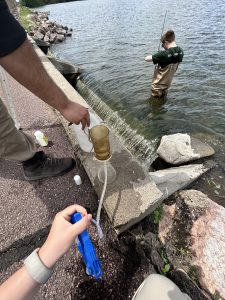 At each site, three sampling bottles provided by the Hygienic Lab were filled to be returned for further laboratory analysis at the end of the sampling session. One bottle contained a small amount of acid that acts as a preservative. Typically containing hydrochloric acid or nitric acid, these samples were used for analyses involving volatile organic compounds (VOCs). The acid prevented any unwanted chemical reactions from occurring, ensuring the sample remained the same from when it was collected until it arrived at the lab. VOCs can be indicative of industrial pollution, wastewater discharge, or contamination from agricultural chemicals, making them a crucial focus for monitoring. The other two bottles were used for collecting suspended solids and total dissolved solids information. Before the sample was placed in one of the bottles, it was filtered using a small vacuum system that pulled the water through selective filter paper. This removed the suspended solids from the water in order to isolate the dissolved solids. (EF)
At each site, three sampling bottles provided by the Hygienic Lab were filled to be returned for further laboratory analysis at the end of the sampling session. One bottle contained a small amount of acid that acts as a preservative. Typically containing hydrochloric acid or nitric acid, these samples were used for analyses involving volatile organic compounds (VOCs). The acid prevented any unwanted chemical reactions from occurring, ensuring the sample remained the same from when it was collected until it arrived at the lab. VOCs can be indicative of industrial pollution, wastewater discharge, or contamination from agricultural chemicals, making them a crucial focus for monitoring. The other two bottles were used for collecting suspended solids and total dissolved solids information. Before the sample was placed in one of the bottles, it was filtered using a small vacuum system that pulled the water through selective filter paper. This removed the suspended solids from the water in order to isolate the dissolved solids. (EF)
Stream flow measurements and water depth were collected using a flow meter. This instrument requires someone to stand in the flowing water and manually count the revolutions of a small wheel that gets pushed by the current. Stream flow is essential for understanding how water moves through ecosystems and influences sediment transport. It also affects water temperature and nutrient distribution, both of which can influence the biological community. Turbidity refers to how cloudy or clear the water is (another measure of suspended solids). This metric was measured using a clear tube with a Secchi disk as the bottom. The tube is calibrated so that water is released from a full tube until the Secchi disk can be seen at the bottom. The depth of the water at this point provides insight into how cloudy the water is and how much light can penetrate through the water column at a given location. (EF)
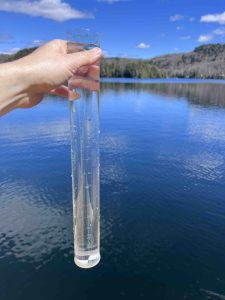

The impact of poor water quality also extends to recreation. The Iowa Great Lakes attract a significant number of visitors each year who come to swim, boat, fish, and enjoy the natural beauty of the area. Poor water quality, especially from nutrient pollution and harmful algae blooms, can reduce the appeal of these lakes for recreational activities, leading to economic losses for local businesses and communities that rely on tourism. Additionally, recreational water users may experience direct health risks from exposure to contaminated water, including skin rashes, gastrointestinal issues, and eye infections. Regular water quality monitoring helps identify sources of pollution, track changes in water conditions over time, and inform management decisions aimed at preserving these important water resources for future generations. (EF)
